Abstract
Understanding and examining energy markets correctly is crucial for stakeholders to attain maximum benefit and avoid risks. As a matter of fact, the volatility that occurred in energy markets and recent crises had major impacts on national economies. Dynamic connectedness relationships (DCRs) can make quite powerful predictions for both low-frequency data and limited time-series data. The objective of this study is to explicate the dynamic connectedness relationships among the BIST sustainability index, BIST 100 index, S&P Global Clean Energy index (S&P GCEI), and S&P GSCI carbon emission allowances (EUA). The daily data obtained over the period 11 April 2014–11 November 2022 were used for the research study. The DCRs among the variables used in the study were investigated by employing the time-varying parameter vector autoregressive (TVP-VAR) model. As a result of the study, the volatility from carbon emission allowances was determined to spill over to S&P GCEI, BIST 100, and BIST sustainability indexes. During the COVID-19 pandemic, significant reductions were detected in the volatility spillover (VS) from carbon emission allowances to S&P GCEI, BIST 100, and BIST sustainability indexes. Moreover, it was revealed that a weak VS existed from S&P GCEI to BIST sustainability and BIST 100 indexes. The findings reveal the importance of policymakers taking some incentive measures in EUA prices and also its role in portfolio diversification.
1. Introduction
Today, although climate change and carbon emissions are becoming major challenges for maintaining a sustainable environment worldwide, carbon emission trading markets are perceived as crucial instruments to promote low-carbon economic development and mitigate greenhouse gas emissions [1]. For instance, Ref. [2] argued that clean energy made a greater contribution to both greenhouse gas reduction and environmental sustainability. In addition, it indicates that the presence of green bonds may establish novice green technologies and maintain the aim of moving towards a sustainable and decarbonized economy [3]. Therefore, green bonds would be considered essential diversified investment tools for environmentally -friendly investors and enterprises [4].
Research on clean energy has attracted a great deal of interest within the last ten years, as the transition to a greener energy system is perceived as an effective means to remove fossil fuel dependence. For this purpose, the association between clean energy indexes and energy commodities and various indexes has been investigated in the literature during recent years [5,6,7,8,9,10]. From a financial perspective, carbon emissions and clean energy markets attract the attention of market participants concerned with climate change and environmental improvements. The price information of both markets affects each other. Therefore, examining the underlying information transfer between EUA (EU carbon price) prices and clean energy stock prices may lead to an important reference for economic decision-makers regarding clean energy development and decarbonization [11].
Nonetheless, the financialization of fossil energy markets empowers the bond with stock markets. In some studies, it has been found that volatility in stock markets has an impact on petroleum returns [12]. Investors’ emotions and behaviors assume crucial roles in such transmission process [13]. Investors consider expected and current returns in both financial and commodity markets when deciding on portfolios. Volatility in the renewable energy market influences demand for other assets, such as fossil energy, and leads to further volatility in fossil energy prices [14].
The objective of this study is to examine the DCRs among Borsa Istanbul (BIST) Sustainability index, BIST 100 index, S&P GCEI, and EUA. In other words, the volatility spillover and receipt of the four variables used in the study are examined. To this end, the 5 day data obtained over the period 2014:11–2022:11 are utilized. This study would make four distinct types of contribution to the relevant literature. Firstly, BIST’s trading volume and liquidity have been increasing significantly throughout recent years. This study is crucial in terms of revealing the preliminary findings on the dynamic interactions and VSs among the BIST sustainability index, BIST 100 index, S&P GCEI consisting of developed and emerging markets, and EUA prices, which are generated according to environmental, social, and governance criteria within the scope of BIST ESG. Secondly, the DCRs among these variables are investigated by employing the recently developed TVP-VAR model. Thirdly, the findings to be obtained in this study would contribute to environmental regulators and policy practitioners in this regard. It would also assist investors to achieve higher returns with lower risks from their well-diversified portfolios. Lastly, volatility in energy markets has a major impact on countries. The volatilities between energy markets and the sustainability index would help prevent the negative impacts that have been observed during the recent energy crises. This study is important in terms of accurately assessing and predicting volatility and risk situations of energy market stakeholders.
This study consists of five parts. In the introduction, the objective and motivations of the study are presented. In the second part, research studies on green finance, S&P GCEI, and EUA are reviewed. In the third part, the dataset, variables, and model used in the study are introduced. In the fourth part, the results of the DCRs among the variables included in the study are revealed. In the last part, an overall assessment of the research study is made and policy recommendations are developed.
2. Review of the Literature
Stakeholder theory is a corporate management theory that supports effective and ethical ways to organize and manage organizational issues in different environmental situations [15,16]. Organizations and institutions deal with issues associated with climate change and decarbonization differently, depending on the extent to which stakeholders relate to each other [17]. The impact degree of each the stakeholders may put pressure on and influence the direction of decision-making [18]. Stakeholder theory, which is associated with actor–network theory, can explore the relationships among multiple actors within the context of sociotechnical transitions toward sustainability in the energy sector. Upon working with stakeholders in the context of actor–network theory and sociotechnical transitions, the questions of whether all actors are stakeholders and technology itself is an actor would arise [19].
In recent years, environmentally-friendly securities gained importance in terms of providing benefits to society in terms of shareholders and firms. In parallel with this, new studies on green or sustainability indexes or green securities began to flourish. For instance, in some studies, the importance of green bonds was demonstrated in reducing non-renewable energy resources and in the use of environmentally-friendly electricity [20,21,22,23,24].
As a result of the research on green bonds, Ref. [25] determined that a positive association existed between environmental values and energy. Therefore, Bloomberg asserted that Barclays MSCI should be included in the S&P green bond. Moreover, Ref. [26] revealed that NDCs and renewable energy had major and significant impacts on green bonds.
Ref. [27] investigated the response of the Chinese Stock Exchange to the issuance of green bonds. As a result of the research, it was revealed that investors reacted positively to the announcements of new green bond issuances. Nonetheless, Ref. [28] found that the green bond index is the most linked index to the carbon market compared to others. Ref. [29] investigated the causality between green bonds and CO2 emissions, and the CO2 emission prices were found to be the Granger cause of the green bond prices, and such causality was unilateral.
Ref. [11] investigated causality between the carbon emission market and the clean energy market. As a result of the study, it was found that when the volatility in the clean energy market was low, the clean energy market had a weak causal impact on the carbon emission market. On the other hand, Ref. [30] determined that a unilateral causality existed from stock markets to the CO2 emission market.
Ref. [31] investigated the causal relationship between China’s carbon emissions and trade markets. As a result of the study, a strong bilateral non-linear causality relationship was found between carbon emissions and trade markets. Similarly, Refs. [32,33,34] demonstrated that dynamic spillover impacts existed between carbon emissions and energy markets.
Ref. [1] explicated the asymmetric relationship between the carbon emissions trading market and the stock market in China. As a result of their research, they found significant and inverse long and short-term asymmetric associations between the carbon emissions trading market and the overall stock market in China. Moreover, at the sector level, the trading price of carbon emissions was found to be significantly correlated between some energy-intensive sectors and the financial sector.
Unlike these studies, Ref. [35] investigated the volatility link between the S&P GCEI and crude West-Texas-type crude oil (WTI), natural gas, kerosene, and fuel oil. As a result of the analysis, the authors revealed weak volatility links among these groups. Ref. [36] examined the dynamic link between solar, wind, and clean energy indexes. Ref. [37] investigated the spillovers among global green bonds, WTI petroleum, and G7 stock markets, and pointed out that spillovers were sensitive to the crisis. Ref. [38] investigated the impact of the ICEA index of cryptocurrency environmental attention on clean energy stocks as well as green bonds, and suggested that ICEA could be a diversification for clean energy stocks and green bonds. Ref. [39] examined the association between green finance, green technology, environmental responsibility, and clean energy. As a result of the analysis, they found bilateral causality among the variables. Upon examining the results of the studies in the literature, it is understood that EUA and S&P GCEI indexes are involved in various sustainability index volatility spillover and receipts. In this context, the hypotheses developed in the research study are as follows:
H1.
There is a dynamic connectedness relationship between BIST sustainability index and EUA index.
H2.
There is a dynamic connectedness between BIST 100 index and EUA index.
H3.
There is a dynamic connectedness relationship between BIST sustainability index and S&P GCEI index.
H4.
There is a dynamic connectedness relationship between BIST 100 index and S&P GCEI index.
H5.
There is a dynamic connectedness relationship between EUA index and S&P GCEI index.
Upon examining the literature on the subject, it is understood that few studies investigating the association between EUA and S&P GCEI exist, and no DCRs are detected among the variables in these studies. Therefore, this study expands the relevant literature. In addition, the relationship among the BIST 100 index, BIST sustainability index, clean energy, and EUA has not been investigated before in the literature. The determination of this situation constitutes the motivation of the study.
3. Methodology
3.1. Dataset
S&P GCEI is designed to measure the performance of enterprises in both emerging and developed markets, with a goaled constituent count of 100. EUA is designed to measure the performance of the EUA market (https://www.spglobal.com/ (accessed on 10 January 2023)). BIST sustainability index is an index of companies whose shares are traded on BIST and whose corporate sustainability performance is high. The BIST 100 index represents the 100 companies with the highest market values. “Clean” and “Carbon” variables used in the study were obtained from www.spglobal.com (accessed on 10 January 2023); whereas Bist100 and BistSust variables were obtained from www.investing.com (accessed on 10 January 2023) webpage. Closing datasets at the daily frequency cover the period of 11 April 2014–11 November 2022 for all variables. The datasets of the variables were converted into return series with the formula ln(Pt/Pt−1) × 100, and then volatility series were obtained by taking the squares of the return series.
3.2. Method
In this research study, the dynamic relationships among the 4 indexes used in the study were examined by employing the TVP-VAR model. Ref. [40] proposed DCR measures based on the TVP-VAR approach by developing connectedness measures based on the fixed-length rolling window VAR approach originally introduced by [41,42,43]. The TVP-VAR model is as follows [40]:
Time-varying coefficients and error covariances are used to estimate the generalized connectedness procedure based on Ref. [43] generalized impulse-response functions and generalized estimation error variance decompositions developed by [44,45]. Here, denotes all available information up to t − 1; and denote m × 1 and mp × 1 column vectors, respectively; and are m × mp and m × m matrixes, respectively; represents a m × 1 column vector; and stands for a p × 1 matrix. and are m × m and p × p time-varying variance-covariance matrixes, respectively. Also, denotes the vectorization of matrix , which is a p × 1 column vector. Prior estimation is made to initialize the Kalman filter. Based on this fact, being equal to ve VAR estimations:
In order to ensure numerical stability in the Kalman filter algorithm, the decay factors suggested by [46] are determined as = 0.99 and = 0.99. Time-varying coefficients and time-varying variance–covariance matrixes are utilized to estimate the generalized connectedness procedure based on generalized impulse response functions (GIRF) and generalized prediction error variance decompositions (GFEVD) developed by [44,45]. For the estimation of GIRF and GFEVD, TVP-VAR needs to be transformed into a vector moving average (VMA) representation within the framework of the Wold decomposition theorem. The VMA representation is transformed as follows:
Here, denotes a mp × mp matrix, represents a mp × 1 column vector, and J stands for a mp × m matrix. GIRFs express the responses of all of the jth variables to a shock in the ith variable. Since it is not a structural model, an H step-ahead estimation of the ith variable both with and without a shock is made, and the difference between them is attributed to the ith variable.
This is as follows:
GFEVD ( representing the bilateral dependence from j to i is estimated and the impact of the jth variable on the ith variable is explained in terms of estimation error variance shares. The variance shares are normalized and all variables altogether explain 100% of the estimation error variance of the ith variable. Its mathematical expression is as follows:
Time-varying coefficients and error covariances are used to estimate the generalized connectedness procedure based on Ref. [43] generalized impulse-response functions and generalized estimation error variance decompositions developed by [44,45]. The total directional connectedness (TDC) index is calculated as follows [40]:
The situation known as “TDC to others”, in which the ith variable transmits its shock to all other jth variables, is as follows:
The situation known as “TDC from others”, in which the ith variable takes its shock from other jth variables, is as follows:
The “net TDC”, which may be interpreted as the “power” of the ith variable or its impact on the network of all variables, is obtained by subtracting the TDC from the others from the TDC to the others as follows:
4. Findings
In this part of the study, the DCRs among the variables used are investigated by employing the TVP-VAR model. In Figure 1, first of all, the time path graphs of the price series of the variables are illustrated.
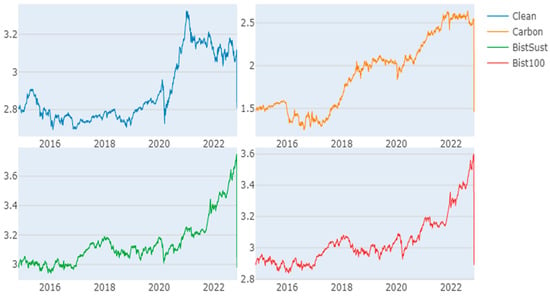
Figure 1.
Price series graphs of the variables used in the study.
Upon examining the price series graphs of the variables in Figure 1, it is understood that there was a great deal of price variability within the last 2 years. Sudden price decreases were observed in these indexes during the COVID-19 pandemic. With the decline in the impacts of the pandemic, an increase existed in these variables until 2022. Since the beginning of 2022, there has been a significant upward trend in these indexes. Unlike the “Carbon”, “Bist100”, and “BistSust” variables, the “Clean” variable demonstrated fluctuating price movements in 2022.
Figure 2 illustrates the volatility series graphs of the variables. The “Carbon” variable has the highest volatility among the variables. Extreme increases in the volatility of all variables are particularly apparent at the beginning of the pandemic and the Russia–Ukraine conflict. However, although the “Carbon” variable has high volatility in all periods, high volatility occurs in the “Clean”, “Bist100”, and “BistSust” variables from the beginning of the COVID-19 pandemic to the end of 2022.
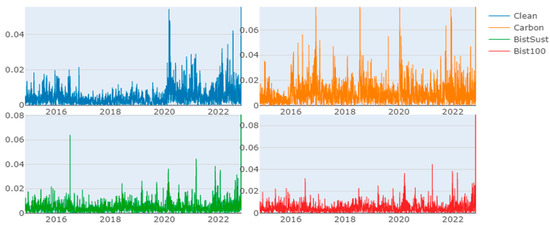
Figure 2.
Volatility series graphs of variables.
Table 1 presents the descriptive statistics of the volatility series. According to the Jarque–Bera test results, it is seen that the variables are not normally distributed. In addition, all variables are stationary at the first level. It is determined that the return series of all variables used in the research are not normally distributed. According to the ERS test developed by [47], all variables are stationary in their returns. Ref. [48] Ljung–Box Q and Q2 test statistics indicate that the series contains various levels of autocorrelation. The autocorrelation of the series indicates that it seems appropriate to employ a TVP-VAR model with time-varying variances.

Table 1.
Descriptive statistics of volatility series of variables.
In Figure 3, the DCRs among variables are investigated with the TVP-VAR model. There is a great deal of VS among the variables from 2017 to the beginning of 2020. Nevertheless, with the outburst of the pandemic, the DCRs among the variables decrease, in other words, the VS declines. Also, towards the end of 2022 and at the beginning of 2016, the DCRs among all variables weaken.
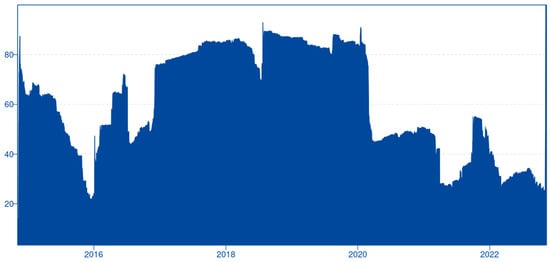
Figure 3.
Dynamic total connectedness relationship of variables.
In Figure 4, the shaded areas below zero level indicate the volatility received in the corresponding date or period, whereas shaded areas above zero level indicate volatility spilled over in the corresponding date or period. According to the results, “Clean”, “BistSust”, and “Bist100” are variables that experience volatility. However, the “Clean” variable is the one from which volatility spills over at the end of 2022. The “Carbon” variable, however, spills high volatility over in all periods. At the beginning of the COVID-19 pandemic, the “Carbon” variable spills the highest volatility, whereas “Clean”, “BistSust”, and “Bist100” variables experience the highest volatility during the same period.
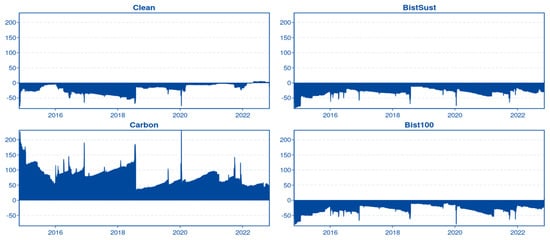
Figure 4.
Net total directional relationships of variables.
Table 2 indicates the average DCR results of the variables during the analysis period. Although the “Clean” variable alone accounts for 60.98% of the volatility change, other variables account for a total of 39.02%. 21.77%, 8.86%, and 8.39% (“Bist100”, “BistSust”, and “Carbon”, respectively) VSs received from the “Clean” variable. Nevertheless, 19.34% volatility from “Clean” spills over to other variables. Accordingly, “Clean” is a variable with a net volatility of 19.68%.

Table 2.
Average dynamic connectedness of variables.
Although the “Carbon” variable alone accounts for 79.51% of the volatility change, all other variables account for a total of 20.49%. 8.20%, 7.96%, and 4.34% (“Bist100”, “BistSust”, and “Clean” variables, respectively) VSs received from the “Carbon” variable. On the other hand, 100.71% volatility from “Carbon” spills over to other variables. Accordingly, “Carbon” is a variable from which a net 80.22% volatility spills over to others.
While “BistSust” accounts for 38.44% of the its volatility change, other variables account for a total of 61.56% volatility. The most volatility (39.77%) from the “Carbon” variable spills over to “BistSust”. In addition, 30.76% volatility of “BistSust” spills over to other variables. Accordingly, “BistSust” is a variable that receives a net volatility of 30.80%. Similarly, “Bist100” accounts for 38.59% of the volatility change, whereas the volatility of the “Carbon” variable spills over to others the most, and a 31.67% net VS is received by the “Carbon” variable. Lastly, since the connectedness among volatilities is quite high (60.83%), portfolio diversification in terms of the mentioned indexes would not be efficient.
Figure 5 and Figure 6 illustrate the volatility received by and spilled over to the variables used in the study, respectively. In support of the results presented in Table 2, the Bist100 and BistSust variables usually receive VS, whereas “Carbon” is a variable from which volatility spills over to others. On the other hand, there is a significant decrease in the VS received by the “Clean” variable as of 2020. In Figure 7, it is seen that the volatility of “Carbon” spills over to other variables. Moreover, the levels of volatility received by and spilled over to other variables are quite low.

Figure 5.
Volatility of variable spills over to others.

Figure 6.
Volatility spillover received by the variables.
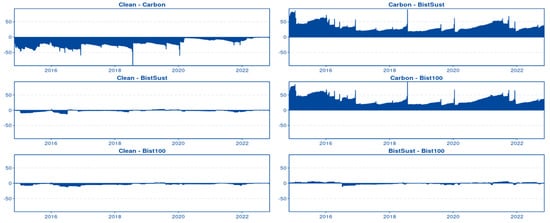
Figure 7.
Net bidirectional connectedness among variables.
In Figure 8, the VS among the volatility series of the variables used in the study are illustrated in the form of a network graph. The blue circles in the graph illustrate the variable(s) whose volatility spills over to others, whereas the yellow circles illustrate the variables that receive VS. Also, the size of the circles indicates the magnitude of the spillover impact. Accordingly, “Carbon” is the variable whose volatility spills over to others, whereas “BistSust”, “Bist100”, and “Clean” are the variables that receive the VS. In other words, the volatility of the “Carbon” variable spills over to the “BistSust”, “Bist100”, and “Clean” variables. The arrows in the graph indicate the direction of the VS and the thickness of the lines along with the arrows indicates the magnitude of the VS. Accordingly, the volatility of the “Carbon” variable spills over more to the “BistSust” and “Bist100” variables than to the “Clean” variable.
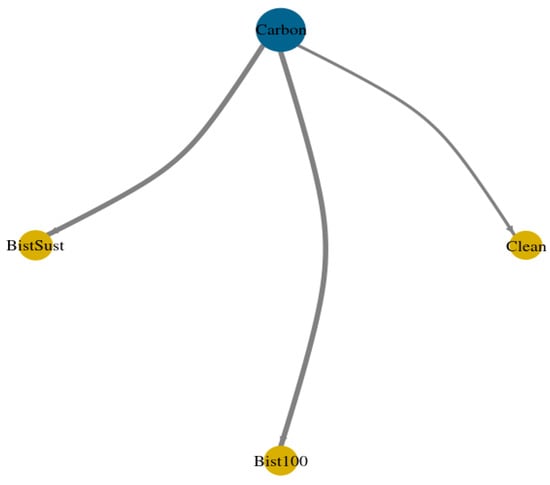
Figure 8.
Network graph representation of volatility spillover of variables.
5. Discussion and Conclusions
Comprehension of the DCR between the carbon emission market and the clean energy market is crucial in investigating the interaction between CO2 emission allocation prices and clean energy asset prices. It is also important for investors in terms of achieving higher returns at lower risks from their well-diversified portfolios and improving portfolio performance. Nonetheless, it is beneficial for the carbon emission market to take effective measures to transfer conventional resources to clean sources, and encourage policymakers with EUA prices.
In this study, the DCRs among S&P GCEI, EUA, and BIST indexes were examined. The daily data obtained over the period 11 April 2014–11 November 2022 were used. The DCRs among the variables used in the study were investigated by employing the TVP-VAR model. It was determined that the volatility of EUA spilled over to S&P GCEI, BIST 100, and BIST sustainability indexes. During the COVID-19 pandemic, significant decreases were detected in the volatility from carbon emission allowances that spilled over to the S&P GCEI, BIST 100, and BIST sustainability indexes. In other words, the DCRs among the markets weaken throughout the global crisis environments. This can be explained by the fact that markets are more severely affected by other factors in crisis environments. Furthermore, the major portion of the volatility from the EUA variable spilled over to the “BistSust” variable. In other words, it can be claimed that the developing BIST sustainability index is affected by the developed carbon emission market. Apart from these findings, it was determined that there was weak VS from S&P GCEI to the BIST sustainability and BIST 100 indexes. The finding suggesting that the volatility of EUA prices spills over to S&P GCEI complies with the findings of Refs. [34,49,50].
5.1. Limitation and Future Research
This study, which investigated the DCRs among S&P GCEI, EUA, and BIST indexes, has some limitations. First of all, the findings should be interpreted in terms of the periods considered. Moreover, empirical findings may differ by different methods employed in empirical studies. Nonetheless, the findings obtained in the study are valid for the BIST 100 and BIST sustainability indexes. It may contradict the findings of studies conducted with the sustainability indexes of different countries’ markets. Also, measuring the clean energy index with the S&P GCEI and the carbon emission with the EUA is another limitation of the research.
Future studies may examine the interactions among EUA and other sustainability and S&P GCEI indexes and green financial assets. Nonetheless, the associations between sustainable crypto assets and clean energy indices and EUA can also be explored. Future studies can examine the relationships of ESG indexes with sustainability indexes, stock market indexes, and clean energy indexes. Moreover, in future studies, comparisons can be made between the periods by categorizing them into groups such as the pre-COVID-19 period, the COVID-19 period, and the Russia–Ukraine war period. Finally, the volatility spreads of sustainable market indices between emerging and developed country stock markets can be compared.
5.2. Implications of the Study
Along with the raised environmental awareness in recent years, many countries prefer cleaner and more efficient energy sources. In this context, the energy market stakeholders are required to accurately assess and predict volatility and risk situations. A more stable energy market affects economic activities and facilitates the execution of economic policies. The stability of energy markets would benefit from preventing the deepening of the crises and mitigating their impacts. Profit-seeking energy market stakeholders such as investors and fund managers should consider the volatility spillover between the BIST sustainability and BIST 100 indexes.
The findings of the research study provide several important implications for both investors and policymakers. EUA has become an important investment instrument with similar financial asset characteristics and high level of liquidity. With the decline in the DCRs during the pandemic, it allows investors to diversify their portfolios in terms of financial assets of the markets. In other words, portfolios containing enterprises pertinent to clean energy and carbon emissions would be considered by financial participants who are interested in environmental improvements. Furthermore, policymakers on this issue can use the EUA as a tool to pressure highly polluted enterprises to use clean energy for preventing climate change. Consequently, ethical investing seeks to support sectors that create a positive impact, such as sustainable energy, and is often compliant with ESG investing. In this context, the findings of this study are important in terms of encouraging investment in these sectors.
Author Contributions
M.D. wrote the sections titled “methodology”, and “findings”; and S.R., B.G. and N.Z. jointly wrote the sections titled “introduction”, “review of the literature”, and “discussion and conclusions”, with equal contributions from the authors. All authors have read and agreed to the published version of the manuscript.
Funding
This research received no external funding.
Institutional Review Board Statement
Not applicable.
Informed Consent Statement
Not applicable.
Data Availability Statement
The data presented in this study are available upon request from the corresponding author.
Conflicts of Interest
The authors declare no conflict of interest.
References
- Wen, F.; Zhao, L.; He, S.; Yang, G. Asymmetric relationship between carbon emission trading market and stock market: Evidences from China. Energy Econ. 2020, 91, 104850. [Google Scholar] [CrossRef]
- Kocaarslan, B.; Soytas, U. Reserve currency and the volatility of clean energy stocks: The role of uncertainty. Energy Econ. 2021, 104, 105645. [Google Scholar] [CrossRef]
- Monasterolo, I.; Raberto, M. The EIRIN flow-of-funds behavioural model of green fiscal policies and green sovereign bonds. Ecol. Econ. 2018, 144, 228–243. [Google Scholar] [CrossRef]
- Wang, X.; Li, J.; Ren, X. Asymmetric causality of economic policy uncertainty and oil volatility index on time-varying nexus of the clean energy, carbon and green bond. Int. Rev. Financ. Anal. 2022, 83, 102306. [Google Scholar] [CrossRef]
- Naeem, M.A.; Peng, Z.; Suleman, M.T.; Nepal, R.; Shahzad, S.J.H. Time and frequency connectedness among oil shocks, electricity and clean energy markets. Energy Econ. 2020, 91, 104914. [Google Scholar] [CrossRef]
- Asl, M.G.; Canarella, G.; Miller, S.M. Dynamic asymmetric optimal portfolio allocation between energy stocks and energy commodities: Evidence from clean energy and oil and gas companies. Resour. Policy 2021, 71, 101982. [Google Scholar] [CrossRef]
- Tan, X.; Geng, Y.; Vivian, A.; Wang, X. Measuring risk spillovers between oil and clean energy stocks: Evidence from a systematic framework. Resour. Policy 2021, 74, 102406. [Google Scholar] [CrossRef]
- Fahmy, H. The rise in investors’ awareness of climate risks after the Paris Agreement and the clean energy-oil-technology prices nexus. Energy Econ. 2022, 106, 105738. [Google Scholar] [CrossRef]
- Hau, L.; Zhu, H.; Sun, W.; Yu, K. Flight-to-quality or not? Evidence from China’s green bond and green equity markets during COVID-19 crisis. Appl. Econ. Lett. 2022, 1–7. [Google Scholar] [CrossRef]
- Chang, K.L.; Lee, C.; He, C.W. Four types of tail dependence structures between US dollar index and S&P 500 stock returns: 1990–2019. Appl. Econ. Lett. 2022, 1–6. [Google Scholar] [CrossRef]
- Lu, X.; Liu, K.; Liang, X.S.; Lai, K.K.; Cui, H. The dynamic causality in sporadic bursts between CO2 emission allowance prices and clean energy index. Environ. Sci. Pollut. Res. 2022, 29, 77724–77736. [Google Scholar] [CrossRef] [PubMed]
- Gomez-Gonzalez, J.E.; Hirs-Garzon, J.; Sanín-Restrepo, S. Dynamic relations between oil and stock markets: Volatility spillovers, networks and causality. Int. Econ. 2021, 165, 37–50. [Google Scholar] [CrossRef]
- Song, Y.; Ji, Q.; Du, Y.J.; Geng, J.B. The dynamic dependence of fossil energy, investor sentiment and renewable energy stock markets. Energy Econ. 2019, 84, 104564. [Google Scholar] [CrossRef]
- Jiang, Y.; Wang, J.; Lie, J.; Mo, B. Dynamic dependence nexus and causality of the renewable energy stock markets on the fossil energy markets. Energy 2021, 233, 121191. [Google Scholar] [CrossRef]
- Harrison, J.S.; Freeman, R.E.; Abreu, M.C.S.D. Stakeholder theory as an ethical approach to effective management: Applying the theory to multiple contexts. Rev. Bras. Gestão Negócios 2015, 17, 858–869. [Google Scholar] [CrossRef]
- Saleem, I.; Tahir, S.H.; Batool, Z. Beyond diversity: Why the inclusion is imperative for boards to promote sustainability among agile non-profit organisations? Int. J. Agil. Syst. Manag. 2021, 14, 254–275. [Google Scholar] [CrossRef]
- Stammer, D.; Van de Wal, R.S.W.; Nicholls, R.J.; Church, J.A.; Le Cozannet, G.; Lowe, J.A.; Behar, D.; Hinkel, J. Framework for high-end estimates of sea level rise for stakeholder applications. Earth’s Future 2019, 7, 923–938. [Google Scholar] [CrossRef]
- Attanasio, G.; Preghenella, N.; De Toni, A.F.; Battistella, C. Stakeholder engagement in business models for sustainability: The stakeholder value flow model for sustainable development. Bus. Strategy Environ. 2022, 31, 860–874. [Google Scholar] [CrossRef]
- Marcon Nora, G.A.; Alberton, A.; Ayala, D.H.F. Stakeholder theory and actor-network theory: The stakeholder engagement in energy transitions. Bus. Strategy Environ. 2023, 32, 673–685. [Google Scholar] [CrossRef]
- Febi, W.; Schäfer, D.; Stephan, A.; Sun, C. The impact of liquidity risk on the yield spread of green bonds. Financ. Res. Lett. 2018, 27, 53–59. [Google Scholar] [CrossRef]
- Glomsrød, S.; Wei, T. Business as unusual: The implications of fossil divestment and green bonds for financial flows, economic growth and energy market. Energy Sustain. Dev. 2018, 44, 1–10. [Google Scholar] [CrossRef]
- Bachelet, M.J.; Becchetti, L.; Manfredonia, S. The green bonds premium puzzle: The role of issuer characteristics and third-party verification. Sustainability 2019, 11, 1098. [Google Scholar] [CrossRef]
- Tang, D.Y.; Zhang, Y. Do shareholders benefit from green bonds? J. Corp. Financ. 2020, 61, 101427. [Google Scholar] [CrossRef]
- Lebelle, M.; Lajili Jarjir, S.; Sassi, S. Corporate green bond issuances: An international evidence. J. Risk Financ. Manag. 2020, 13, 25. [Google Scholar] [CrossRef]
- Kanamura, T. Are green bonds environmentally friendly and good performing assets? Energy Econ. 2020, 88, 104767. [Google Scholar] [CrossRef]
- Tolliver, C.; Keeley, A.R.; Managi, S. Policy targets behind green bonds for renewable energy: Do climate commitments matter? Technol. Forecast. Soc. Chang. 2020, 157, 120051. [Google Scholar] [CrossRef]
- Wang, J.; Lu, X.; He, F.; Ma, F. Which popular predictor is more useful to forecast international stock markets during the coronavirus pandemic: VIX vs. EPU? Int. Rev. Financ. Anal. 2020, 72, 101596. [Google Scholar] [CrossRef]
- Jin, Y.; Gao, X.; Wang, M. The financing efficiency of listed energy conservation and environmental protection firms: Evidence and implications for green finance in China. Energy Policy 2021, 153, 112254. [Google Scholar] [CrossRef]
- Hammoudeh, S.; Ajmi, A.N.; Mokni, K. Relationship between green bonds and financial and environmental variables: A novel time-varying causality. Energy Econ. 2020, 92, 104941. [Google Scholar] [CrossRef]
- Chang, C.L.; Ilomäki, J.; Laurila, H.; McAleer, M. Causality between CO2 emissions and stock markets. Energies 2020, 13, 2893. [Google Scholar] [CrossRef]
- Zhao, L.; Wen, F.; Wang, X. Interaction among China carbon emission trading markets: Nonlinear Granger causality and time-varying effect. Energy Econ. 2020, 91, 104901. [Google Scholar] [CrossRef]
- Ji, Q.; Zhang, D.; Geng, J.B. Information linkage, dynamic spillovers in prices and volatility between the carbon and energy markets. J. Clean. Prod. 2018, 198, 972–978. [Google Scholar] [CrossRef]
- Wang, Y.; Guo, Z. The dynamic spillover between carbon and energy markets: New evidence. Energy 2018, 149, 24–33. [Google Scholar] [CrossRef]
- Gargallo, P.; Lample, L.; Miguel, J.A.; Salvador, M. Co-movements between EU ETS and the energy markets: A VAR-DCC-GARCH approach. Mathematics 2021, 9, 1787. [Google Scholar] [CrossRef]
- Umar, M.; Farid, S.; Naeem, M.A. Time-frequency connectedness among clean-energy stocks and fossil fuel markets: Comparison between financial, oil and pandemic crisis. Energy 2022, 240, 122702. [Google Scholar] [CrossRef]
- Tiwari, A.K.; Abakah, E.J.A.; Gabauer, D.; Dwumfour, R.A. Dynamic spillover effects among green bond, renewable energy stocks and carbon markets during COVID-19 pandemic: Implications for hedging and investments strategies. Glob. Financ. J. 2022, 51, 100692. [Google Scholar] [CrossRef]
- Mensi, W.; Naeem, M.A.; Vo, X.V.; Kang, S.H. Dynamic and frequency spillovers between green bonds, oil and G7 stock markets: Implications for risk management. Econ. Anal. Policy 2022, 73, 331–344. [Google Scholar] [CrossRef]
- Kamal, J.B.; Hassan, M.K. Asymmetric connectedness between cryptocurrency environment attention index and green assets. J. Econ. Asymmetries 2022, 25, e00240. [Google Scholar] [CrossRef]
- Madaleno, M.; Dogan, E.; Taskin, D. A step forward on sustainability: The nexus of environmental responsibility, green technology, clean energy and green finance. Energy Econ. 2022, 109, 105945. [Google Scholar] [CrossRef]
- Antonakakis, N.; Gabauer, D. Refined Measures of Dynamic Connectedness Based on TVP-VAR; MPRA Paper No. 78282; University Library of Munich: Munich, Germany, 2017. [Google Scholar]
- Diebold, F.X.; Yilmaz, K. Measuring financial asset return and volatility spillovers, with application to global equity markets. Econ. J. 2009, 119, 158–171. [Google Scholar] [CrossRef]
- Diebold, F.X.; Yilmaz, K. Better to give than to receive: Predictive directional measurement of volatility spillovers. Int. J. Forecast. 2012, 28, 57–66. [Google Scholar] [CrossRef]
- Diebold, F.X.; Yilmaz, K. On the network topology of variance decompositions: Measuring the connectedness of financial firms. J. Econom. 2014, 182, 119–134. [Google Scholar] [CrossRef]
- Koop, G.; Pesaran, M.H.; Potter, S.M. Impulse Response Analysis in Nonlinear Multivariate Models. J. Econom. 1996, 74, 119–147. [Google Scholar] [CrossRef]
- Pesaran, H.H.; Shin, Y. Generalized impulse response analysis in linear multivariate models. Econ. Lett. 1998, 58, 17–29. [Google Scholar] [CrossRef]
- Koop, G.; Korobilis, D. A new index of financial conditions. Eur. Econ. Rev. 2014, 71, 101–116. [Google Scholar] [CrossRef]
- Elliott, G.; Rothenberg, T.J.; Stock, J.H. Efficient tests for an autoregressive unit root. Econometrica 1992, 64, 813–836. [Google Scholar] [CrossRef]
- Fisher, T.J.; Gallagher, C.M. New weighted portmanteau statistics for time series goodness of fit testing. J. Am. Stat. Assoc. 2012, 107, 777–787. [Google Scholar] [CrossRef]
- Hanif, W.; Hernandez, J.A.; Mensi, W.; Kang, S.H.; Uddin, G.S.; Yoon, S.M. Nonlinear dependence and connectedness between clean/renewable energy sector equity and European emission allowance prices. Energy Econ. 2021, 101, 105409. [Google Scholar] [CrossRef]
- Tu, Q.; Mo, J.; Liu, Z.; Gong, C.; Fan, Y. Using green finance to counteract the adverse effects of COVID-19 pandemic on renewable energy investment-The case of offshore wind power in China. Energy Policy 2021, 158, 112542. [Google Scholar] [CrossRef]
Disclaimer/Publisher’s Note: The statements, opinions and data contained in all publications are solely those of the individual author(s) and contributor(s) and not of MDPI and/or the editor(s). MDPI and/or the editor(s) disclaim responsibility for any injury to people or property resulting from any ideas, methods, instructions or products referred to in the content. |
© 2023 by the authors. Licensee MDPI, Basel, Switzerland. This article is an open access article distributed under the terms and conditions of the Creative Commons Attribution (CC BY) license (https://creativecommons.org/licenses/by/4.0/).